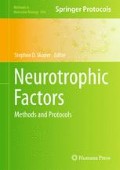Abstract
Fusion of fluorescent probes to axonally transported proteins represents an established approach that enables live imaging of axonal transport. In this approach, in vivo examination of fluorescent particle dynamics provides information about the length, directionality, and the velocity by which axonally transported proteins travel along axons. Analysis of these parameters provides information about the distribution of axonal proteins and their dynamics in and between different subcellular compartments. Establishing the movement behavior of amyloid precursor protein within axons indicated that live imaging approaches offer the opportunity to significantly enhance our understanding of the biology as well as pathology of axonal transport. This chapter provides a fluorescence-based procedure for measuring axonal transport of APP in cultured newborn mouse hippocampal neurons.
Access this chapter
Tax calculation will be finalised at checkout
Purchases are for personal use only
References
Hirokawa N, and Noda Y (2008) Intracellular transport and kinesin superfamily proteins, KIFs: structure, function, and dynamics. Physiol Rev 88, 1089–1118
Kang J, Lemaire HG, Unterbeck A, Salbaum JM, Masters CL, Grzeschik KH, et al (1987) The precursor of Alzheimer’s disease amyloid A4 protein resembles a cell-surface receptor. Nature 325, 733–736
Bertram L, Lill CM, and Tanzi RE (2010) The genetics of Alzheimer disease: back to the future. Neuron 68, 270–281
Goedert M, and Spillantini MG (2006) A century of Alzheimer’s disease. Science 314, 777–781
Cras P, Kawai M, Lowery D, Gonzalez-DeWhitt P, Greenberg B, and Perry G (1991) Senile plaque neurites in Alzheimer disease accumulate amyloid precursor protein. Proc Natl Acad Sci U S A 88, 7552–7556
Stokin GB, and Goldstein LS (2006) Axonal transport and Alzheimer’s disease. Annu Rev Biochem 75, 607–627
Stokin GB, and Goldstein LS (2006) Linking molecular motors to Alzheimer’s disease. J Physiol Paris 99, 193–200
Joachim CL, Duffy LK, Morris JH, and Selkoe DJ (1988) Protein chemical and immunocytochemical studies of meningovascular beta-amyloid protein in Alzheimer’s disease and normal aging. Brain Res 474, 100–111
Koo EH, Sisodia SS, Archer DR, Martin LJ, Weidemann A, Beyreuther K, et al (1990) Precursor of amyloid protein in Alzheimer disease undergoes fast anterograde axonal transport. Proc Natl Acad Sci U S A 87, 1561–1565
Kaether C, Skehel P, and Dotti CG (2000) Axonal membrane proteins are transported in distinct carriers: a two-color video microscopy study in cultured hippocampal neurons. Mol Biol Cell 11, 1213–1224
Goldsbury C, Thies E, Konzack S, and Mandelkow EM (2007) Quantification of amyloid precursor protein and tau for the study of axonal traffic pathways. J Neurosci 27, 3357–3363
Stokin GB, Lillo C, Falzone TL, Brusch RG, Rockenstein E, Mount SL, et al (2005) Axonopathy and transport deficits early in the pathogenesis of Alzheimer’s disease. Science 307, 1282–1288
Stokin GB, Almenar-Queralt A, Gunawardena S, Rodrigues EM, Falzone T, Kim J, et al (2008) Amyloid precursor protein-induced axonopathies are independent of amyloid-beta peptides. Hum Mol Genet 17, 3474–3486
Falzone TL, Stokin GB, Lillo C, Rodrigues EM, Westerman EL, Williams DS, et al (2009) Axonal stress kinase activation and tau misbehavior induced by kinesin-1 transport defects. J Neurosci 29, 5758–5767
Araki Y, Kawano T, Taru H, Saito Y, Wada S, Miyamoto K, et al (2007) The novel cargo Alcadein induces vesicle association of kinesin-1 motor components and activates axonal transport. EMBO J 26, 1475–1486
Eva R, Dassie E, Caswell PT, Dick G, ffrench-Constant C, Norman JC, et al (2010) Rab11 and its effector Rab coupling protein contribute to the trafficking of beta 1 integrins during axon growth in adult dorsal root ganglion neurons and PC12 cells. J Neurosci 30, 11654–11669
Bilsland LG, Sahai E, Kelly G, Golding M, Greensmith L, and Schiavo G (2010) Deficits in axonal transport precede ALS symptoms in vivo. Proc Natl Acad Sci U S A 107, 20523–20528
Acknowledgements
This work was supported by PICT-2008-0293 (ANPCyT)(T.L.F.), Alzheimer Association NIRG-10-172840 Grant (T.L.F.) and P3-0338 grant from the Slovenian Research Agency (G.B.S.).
Author information
Authors and Affiliations
Corresponding author
Editor information
Editors and Affiliations
Rights and permissions
Copyright information
© 2012 Springer Science+Business Media, LLC
About this protocol
Cite this protocol
Falzone, T.L., Stokin, G.B. (2012). Imaging Amyloid Precursor Protein In Vivo: An Axonal Transport Assay. In: Skaper, S. (eds) Neurotrophic Factors. Methods in Molecular Biology, vol 846. Humana Press. https://doi.org/10.1007/978-1-61779-536-7_25
Download citation
DOI: https://doi.org/10.1007/978-1-61779-536-7_25
Published:
Publisher Name: Humana Press
Print ISBN: 978-1-61779-535-0
Online ISBN: 978-1-61779-536-7
eBook Packages: Springer Protocols

